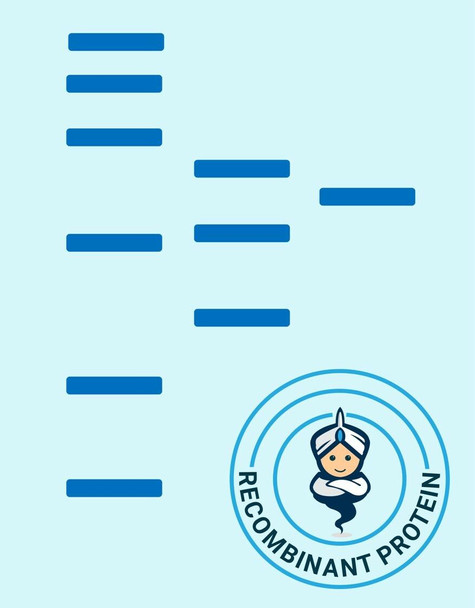Description
| Product Name: | Human APOA1 Recombinant Protein |
| Product Code: | RPPB0047 |
| Size: | 100µg |
| Species: | Human |
| Target: | APOA1 |
| Synonyms: | Apolipoprotein A-I, Apo-AI, ApoA-I, APOA1, MGC117399. |
| Source: | Human HDL |
| Physical Appearance: | Sterile filtered colorless solution. |
| Formulation: | The APOA1 1mg/ml solution contains 10mM Ammonium Bicarbonate at pH7.4. |
| Stability: | APOA1 although stable at 4°C for 1 week, should be stored below -18°C. For long term storage it is recommended to add a carrier protein (0.1% HSA or BSA).Please prevent freeze thaw cycles. |
| Purity: | Greater than 95.0% as determined by SDS-PAGE. |
APOA1 (Apolipoprotein A-1) is a human protein with a specific role in lipid metabolism being the main protein component of HDL in the plasma. APOA1 promotes cholesterol efflux from tissues to the liver for excretion. Furthermore, APOA1 is a cofactor for LCAT, which is responsible for the formation of most plasma cholesteryl esters. In addition, APOA1 activates spermatozoa motility as part of the SPAP complex. The APOA1 gene is strongly linked with two other apolipoprotein genes on chromosome 11. Defects in the APOA1 gene are linked to HDL deficiency including Tangier disease, and with systemic non-neuropathic amyloidosis. High levels of APOA1 are linked to the manifestation of asthma and atopy.
APOA1 Human�isolated from Human HDL�is a single, glycosylated, polypeptide chain having a molecular mass of 28.3kDa.�APOA1 is purified using delipidation and gel permeation chromatographic technique.
| UniProt Protein Function: | APOA1: Participates in the reverse transport of cholesterol from tissues to the liver for excretion by promoting cholesterol efflux from tissues and by acting as a cofactor for the lecithin cholesterol acyltransferase (LCAT). As part of the SPAP complex, activates spermatozoa motility. Interacts with APOA1BP and CLU. Component of a sperm activating protein complex (SPAP), consisting of APOA1, an immunoglobulin heavy chain, an immunoglobulin light chain and albumin. Interacts with NDRG1. Major protein of plasma HDL, also found in chylomicrons. Synthesized in the liver and small intestine. The oxidized form at Met-110 and Met-136 is increased in individuals with increased risk for coronary artery disease, such as in carrier of the eNOSa/b genotype and exposure to cigarette smoking. It is also present in increased levels in aortic lesions relative to native ApoA-I and increased levels are seen with increasing severity of disease. Belongs to the apolipoprotein A1/A4/E family. |
| UniProt Protein Details: | Protein type:Lipid-binding; Secreted, signal peptide; Secreted; Vesicle; Motility/polarity/chemotaxis; Cell development/differentiation; Endoplasmic reticulum Chromosomal Location of Human Ortholog: 11q23-q24 Cellular Component: extracellular space; chylomicron; cell surface; endocytic vesicle; endoplasmic reticulum lumen; early endosome; extracellular region; plasma membrane; cytoplasmic vesicle; nucleus; cytosol; vesicle Molecular Function:identical protein binding; protein binding; enzyme binding; phospholipid transporter activity; lipase inhibitor activity; beta-amyloid binding; chemorepellent activity; cholesterol transporter activity; cholesterol binding; phospholipid binding; phosphatidylcholine binding; apolipoprotein A-I receptor binding; high-density lipoprotein binding; apolipoprotein receptor binding Biological Process: phototransduction, visible light; negative chemotaxis; negative regulation of lipase activity; axon regeneration in the peripheral nervous system; sequestering of lipid; negative regulation of interleukin-1 beta secretion; regulation of cholesterol absorption; transforming growth factor beta receptor signaling pathway; positive regulation of stress fiber formation; response to drug; platelet activation; cholesterol metabolic process; organ regeneration; regulation of Cdc42 protein signal transduction; adrenal gland development; positive regulation of hydrolase activity; positive regulation of Rho protein signal transduction; lipoprotein metabolic process; positive regulation of transferase activity; vitamin transport; cholesterol biosynthetic process; negative regulation of cytokine secretion during immune response; cholesterol homeostasis; lipoprotein biosynthetic process; response to estrogen stimulus; peptidyl-methionine modification; phosphatidylcholine biosynthetic process; positive regulation of lipoprotein lipase activity; blood vessel endothelial cell migration; cellular lipid metabolic process; platelet degranulation; phospholipid efflux; retinoid metabolic process; transmembrane transport; response to nutrient; phospholipid homeostasis; integrin-mediated signaling pathway; receptor-mediated endocytosis; positive regulation of fatty acid biosynthetic process; regulation of protein amino acid phosphorylation; cholesterol transport; protein stabilization; protein amino acid oxidation; negative regulation of heterotypic cell-cell adhesion; neurite regeneration; cholesterol efflux; G-protein coupled receptor protein signaling pathway; glucocorticoid metabolic process; reverse cholesterol transport; endothelial cell proliferation; negative regulation of inflammatory response; blood coagulation Disease: Hypoalphalipoproteinemia, Primary; Amyloidosis, Familial Visceral |
| NCBI Summary: | This gene encodes apolipoprotein A-I, which is the major protein component of high density lipoprotein (HDL) in plasma. The protein promotes cholesterol efflux from tissues to the liver for excretion, and it is a cofactor for lecithin cholesterolacyltransferase (LCAT) which is responsible for the formation of most plasma cholesteryl esters. This gene is closely linked with two other apolipoprotein genes on chromosome 11. Defects in this gene are associated with HDL deficiencies, including Tangier disease, and with systemic non-neuropathic amyloidosis. [provided by RefSeq, Jul 2008] |
| UniProt Code: | P02647 |
| NCBI GenInfo Identifier: | 113992 |
| NCBI Gene ID: | 335 |
| NCBI Accession: | P02647.1 |
| UniProt Secondary Accession: | P02647,Q6LDN9, Q6Q785, Q9UCS8, Q9UCT8, A8K866, |
| UniProt Related Accession: | P02647 |
| Molecular Weight: | 30,778 Da |
| NCBI Full Name: | Apolipoprotein A-I |
| NCBI Synonym Full Names: | apolipoprotein A-I |
| NCBI Official Symbol: | APOA1�� |
| NCBI Protein Information: | apolipoprotein A-I; apo-AI |
| UniProt Protein Name: | Apolipoprotein A-I |
| UniProt Synonym Protein Names: | Apolipoprotein A1Cleaved into the following 2 chains:Proapolipoprotein A-I; ProapoA-I; Truncated apolipoprotein A-IAlternative name(s):Apolipoprotein A-I(1-242) |
| Protein Family: | Apolipoprotein |
| UniProt Gene Name: | APOA1�� |
| UniProt Entry Name: | APOA1_HUMAN |









